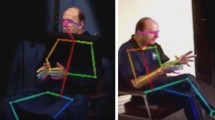Abstract
Empirical studies of gesture in a subject who has lost proprioception and the sense of touch from the neck down show that specific aspects of gesture remain normal despite abnormal motor processes for instrumental movement. The experiments suggest that gesture, as a linguistic phenomenon, is not reducible to instrumental movement. They also support and extend claims made by Merleau-Ponty concerning the relationship between language and cognition. Gesture, as language, contributes to the accomplishment of thought.
Similar content being viewed by others
References
Allot, R. 1992. The motor theory of language: origin and function. In: J. Wind et al. (eds). Language Origin: A Multidisciplinary Approach. Dordrecht: Kluwer.
Anscombe, G.E.M. 1979. Intention. London: Basil Blackwell.
Blouin, J., Gauthier, G.M., Vercher J.-L. and Cole, J. 1996. The relative contribution of retinal and extraretinal signals in determining the accuracy of reaching movements in normal subjects and a deafferented patient. Experimental Brain Research 109: 148-153.
Cole, J. 1995. Pride and a Daily Marathon. Cambridge, MA: MIT Press (originally London: Duckworth, 1991).
Cole, J., Gallagher, S., McNeill, D., Duncan S., Furuyama, N. and McCullough, K.-E. 1998. Gestures after total deafferentation of the bodily and spatial senses. In: Santi et al. (eds). Oralité et gestualité: Communication Multi-modale, Interaction, pp. 65-69. Paris: L. Harmattan.
Cole, J. and J. Paillard. 1996. Living without touch and peripheral information about body position and movement: studies upon deafferented subjects. In: J. Bermúdez, A. Marcel and N. Eilan (eds). The Body and the Self, pp. 245-266. Cambridge, MA: MIT/Bradford Press.
Denny-Brown, D., Meyer, J.S. and Horenstein, S. 1952. The significance of perceptual rivalry resulting from parietal lesion. Brain 75: 433-471.
Gallagher, S. and Cole, J. 1995. Body schema and body image in a deafferented subject. Journal of Mind and Behavior 16: 369-390.
Gallagher, S., Cole, J. and McNeill, D. 2001. The language-thought-hand system. In C. Cave, I. Guaitella and S. Santi (eds). Oralité et gestualité: Interactions et comportements multimodaux dans la communication, pp. 420-424. Paris: L'Harmattan.
Iverson, J.M. and Goldin-Meadow, S. 1998. Why people gesture when they speak.Nature (19 November 1998): 228.
Iverson, J.M. and Thelen, E. 1999. Hand, mouth and brain: The dynamic emergence of speech and gesture. Journal of Consciousness Studies 6(11-12): 19-40.
Kita, S. 2000. How representational gestures help speaking. In: D. McNeill (ed). Language and Gesture, pp. 162-185. Cambridge: Cambridge University Press.
LeBaron, C. and Streeck, J. (2000). Gestures, knowledge, and the world. In: D. McNeill (ed). Language and Gesture, pp. 118-138. Cambridge: Cambridge University Press.
Marcel, A.J. 1992. The personal level in cognitive rehabilitation. In: N. von Steinbuchel, E. Poppel and D. von Cramon (eds). Neurophychological Rehabilitation, pp. 155-168. Berlin: Springer.
Milner, D. 1998. Unconscious visual processing for action: Neuropsychological evidence. Paper presented at Towards a Science of Consciousness, Third Conference, Tucson, April 27, 1998.
Merleau-Ponty, M. 1962. Phenomenology of Perception, tr. C. Smith. London: Routledge and Kegan Paul.
McNeill, D. 1985. So you think gestures are non-verbal? Psychological Review 92: 350-371.
McNeill, D. 1992. Hand and Mind: What Gestures Reveal about Thought. Chicago: University of Chicago Press.
Ogden, J.A. 1996. Fractured Minds: A Case-Study Approach to Clinical Neuropsychology. Oxford: Oxford University Press.
Ojemann, G.A. 1984. Common cortical and thalamic mechanisms for language and motor functions. American Journal of Physiology 246 (Regulatory Integrative and Comparative Physiology 15): R901-R903.
Pribram, K.H. 1999. Brain and the composition of conscious experience. Journal of Consciousness Studies 6 (5): 19-42.
Ricoeur, P. 1992. Oneself as Another, tr. K. Blamey. Chicago: University of Chicago Press.
Streeck, J. 1996. How to do things with things: Objects trovés and symbolization. Human Studies 19: 365-384.
Vercher, J-L., Gauthier, G.M., Guedon, O., Blouin, J., Cole J. and Lamarre, Y. 1996. Selfmoved target eye tracking in control and deafferented subjects: Roles of arm command and proprioception in arm-eye coordination. Journal of Neurophysiology 76 (2): 1133-44.
Author information
Authors and Affiliations
Rights and permissions
About this article
Cite this article
Cole, J., Gallagher, S. & McNeill, D. Gesture following deafferentation: a phenomenologically informed experimental study. Phenomenology and the Cognitive Sciences 1, 49–67 (2002). https://doi.org/10.1023/A:1015572619184
Issue Date:
DOI: https://doi.org/10.1023/A:1015572619184




